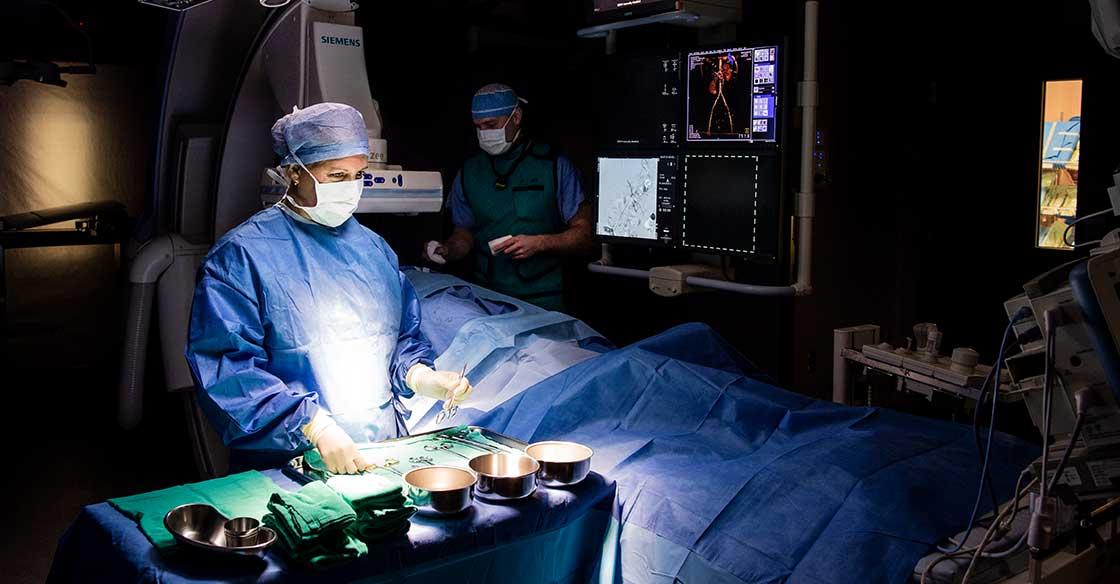
Interventional radiology (IR) nurse Melanie Carrigan (front) and radiology technologist Wesley Young are part of the QEII’s world-class IR team, who have continued to deliver extraordinary care during COVID-19. – Mike Tompkins
Originally published on qe2times.ca.
During the initial peak of COVID-19 in Nova Scotia, our province – and the world – had seemingly come to a halt.
Many businesses had temporarily shut their doors and the once-busy streets felt quiet and empty.
But inside the QEII Health Sciences Centre, certain healthcare teams, like Interventional Radiology (IR), were bustling.
IR teams play an integral role in caring for patients from head-to-toe, treating conditions like cancer, stroke and dangerous bleeding with the most minimally-invasive procedures possible.
Under their watch, life-threatening blood clots are eliminated with the nick of an incision, while cancerous tumours are burned and treated through tiny pinholes rather than major surgery.
When COVID-19 first hit, all but life-saving and time-sensitive surgeries and services were postponed across the province. In the world of IR, often every second counts – which is why not an even a global pandemic could stop some of these IR procedures at the QEII.
As many healthcare services and elective procedures began to resume, the IR team continued to stand on guard: triaging cases based on their history and urgency and in some cases providing another, more immediate option to patients awaiting surgeries that were initially postponed.
For IR nurse, Melanie Carrigan, it was these bustling moments and times of unprecedented change that inspired a sense of pride she says is hard to describe.
“Whether it was dealing with sudden school and childcare closures to the added stress and pressures at home, this pandemic hit everyone differently,” says Melanie. “No matter what was happening in our personal lives, our teams showed up: ready to give all they had to protect our patients and each other.”
It’s a sentiment shared by Dr. Christopher Lightfoot, QEII Interventional Radiologist.
“For many of us, these extraordinary circumstances created one of the most stressful times in our careers,” he says. “But to see our teams continually step up, pitch in and set aside those fears for patient care is incredibly rewarding.”
COVID-19 changed many things for the QEII’s IR team, including how they care for their patients: those who test positive for the virus, those still awaiting test results, and those who are incredibly vulnerable because of other health conditions.
According to Dr. Lightfoot, the IR team is not often treating COVID-positive patients for the virus itself, but rather other underlying and life-altering health issues.
From resolving dangerous bleeding to inserting and replacing life-saving tubes and catheters, this important care continues – regardless of a patient’s COVID-19 diagnosis.
“In the early days as we learned more about the virus, our COVID-19 protocols were changing by the hour,” says Katrina Boudreau, IR technologist at the QEII. “From start to finish, some IR procedures were taking us three times as long in order to minimize the risk of potential exposure.”
Katrina, Melanie and Dr. Lightfoot all credit the establishment of their department’s own COVID-19 Task Force for keeping their team informed, engaged and, most importantly, safe.
“When the pandemic first hit, we introduced new protocols for almost every aspect of our job,” says Melanie. “Our task force ensured we always had all the information and tools needed to deliver the best care possible to our patients.”
New protocols included everything from how a patient is transported to and from a procedure to limiting the equipment – and staff – within the IR suites.
In early April, the COVID-19 Task Force introduced “temporary pods” within IR; staff organized into independent teams who didn’t interact with one another and formed their own exclusive workplace bubble.
“This meant that if a pod was exposed and had to quarantine, the remaining IR teams could continue to provide care,” says Katrina.
Thanks to our province’s efforts to combat the spread of the virus, things are “mostly back” to a new normal for the QEII’s IR team.
For staff members like Katrina, she says the pandemic has had its silver linings.
“While we’re bumping elbows instead of giving high fives, you just appreciate your colleagues so much more and that you’re in it together,” says Katrina. “From our porters and booking clerks to the nurses and radiologists, I’ve never been more proud to be a part of it all.”
With the support of QEII Foundation donors, this life-saving area is set for an expansion and even better patient experience. To learn more about the QEII’s new IR suites and to donate today, visit QE2IRSuites.ca.